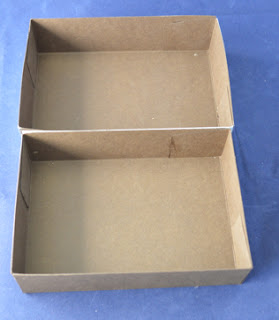"The Beehive - Front Cover"
This card has the same structure as the screen card tutorial I shared earlier this week. Rather than dry embossing, each of the frames is heat-embossed. Usually I make the inside of the card more highly coloured and decorated than the cover because I like a contrast, but this card has the opposite approach. I wanted to fill the card with "frames" of bees such as you would get in a real beehive, so I made the cover more colourful.
"Colour Detail"
Every bit of colour comes from embossing powders. These are nothing special, just a cheap set bought from Ebay when I first started heat-embossing a few years ago. The background uses Birgit Koopsen's technique, but I wanted the more detailed images in the foreground to have some colour too, so the beehive itself is stamped onto scrap white card and the stamp used as guidelines for colouring with the embossing powders, before heating, cutting out, shaping and sticking onto the background using Pinflair for extra dimension. The flowers are diecut from white card and also decorated with heat-embossing. I really had to stop myself reaching for the inks to decorate the edges of the diecuts as I would normally do. I hate those white edges lol!
"The Beehive - Inside Panels"
The inside panels are also decorated solely using embossing powders. The frames use a bronze-coloured cheap powder, which is used patchily to create lots of texture (hopefully it looks like beaten metal). The panels are all joined together using bailer twine. Bailer twine is a magic item on the farm. Historically, it was used in the hay bailer machinery to tie the bails of hay, although these days they don't make much hay any more (it's all gone over to great big tractors making silage wrapped in black plastic). But bailer twine has a million and one other uses too - repairing all sorts of things, tying farm gates to broken gateposts (usually broken by those big tractors!), makeshift leads for the dogs, etc. Today I found another use for it - joining screen card panels together. It seemed apt somehow :-)
"Individual Panel"
The background is made by dry embossing white card using a Darice embossing folder rubbed with versamark, then colouring with "honey" coloured embossing powder and a sprinkling of light brown (real honeycomb always has bits of bee poo in it lol!). I added more of the light brown to enhance the outline of individual cells using a versamark pen.
"Another Individual Panel"
This panel has more of the brown colour. In a real hive, older frames are darker than newer ones. If you want to produce honeycomb to eat, it has to be made from scratch in the year it is produced so that it is a nice, clean, light colour. It's obviously more work for the bees because they have to make the wax as well as the honey, whereas they prefer to reuse wax they made in previous years.
"Bee!"
These fat-bottomed bees are bumblebees rather than honeybees, but you'll just have to allow me a little artistic license :-) The bees are stamped onto spare white cardand heat-embossed in gold. The individual stripes are made using a versamark pen and heat-embossed in honey colour. Finally, the bees are individually cut out, shaped and mounted onto the frames using Pinflair for extra dimension.
"The Back"
Even the back is decorated with heat-embossing, but has been left much plainer to allow the future addition of sentiment panels if required.
"Bee Charm"
These little bee charms are hung from the bailer twine for a finishing touch.
Well, I hope you enjoyed this card and glimpses of a rural life today. The weather here in Northern Ireland is cold, windy and frequently wet, but life is good here.
Ingredients
Sizzix Bigz Vintage Cabinet and M&S Cabinet dies
Spellbinders Die D-Lites - Floral Border
Chocolate Baroque stamp set: Honey Bee
Artemio stamp sets: Butterflies, Bugs and Insects, Wild Meadow
Crafty Secrets Stamp set: Queen Bee
IndigoBlu stamp: Honeycomb Background
Cardstock: brown 300gsm, white 160gsm & 220gsm
Embossing folder: Darice chicken wire
Embossing Powders: Imagepac set of 12 colours, Stampendous Pirate Gold
Ink pads: Balck Archival, Versamark Clear
1/8" Brass Eyelets
Bailer Twine
Bee Charms
Entered for the following challenges:
Craft Stamper Take it Make it Challenge 3
Simon Says Stamp and Show - Stripes






















































